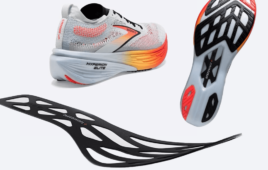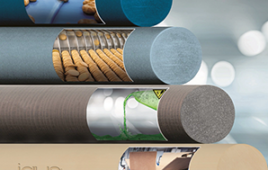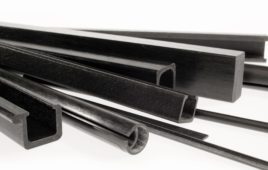 Using molds to shape things is as old as humanity. In the Bronze Age, the copper-tin alloy was melted and cast into weapons in ceramic molds. Today, injection and extrusion molding shape hot liquids into everything from car parts to toys.
Using molds to shape things is as old as humanity. In the Bronze Age, the copper-tin alloy was melted and cast into weapons in ceramic molds. Today, injection and extrusion molding shape hot liquids into everything from car parts to toys.
For this to work, the mold needs to be stable while the hot liquid material hardens into shape. In a breakthrough for nanoscience, Cornell polymer engineers have made such a mold for nanostructures that can shape liquid silicon out of an organic polymer material. This paves the way for perfect, 3-D, single crystal nanostructures.
The advance is from the lab of Uli Wiesner, Professor of Engineering in the Department of Materials Science and Engineering, whose lab previously has led the creation of novel materials made of organic polymers. With the right chemistry, organic polymers self-assemble, and the researchers used this special ability of polymers to make a mold dotted with precisely shaped and sized nano-pores.
The research is published in Science July 3: http://www.sciencemag.org/content/349/6243/54.full
Normally, melting amorphous silicon, which has a melting temperature of about 2,350 degrees, would destroy the delicate polymer mold, which degrades at about 600 degrees. But the scientists, in collaboration with Michael Thompson, associate professor of materials science and engineering, got around this issue by using extremely short melt periods induced by a laser.
The researchers found the polymer mold holds up if the silicon is heated by laser pulses just nanoseconds long. At such short time scales, silicon can be heated to a liquid, but the melt duration is so short the polymer doesn’t have time to oxidize and decompose. They essentially tricked the polymer mold into retaining its shape at temperatures above its decomposition point.
When the mold was etched away, the researchers showed that the silicon had been perfectly shaped by the mold. This could lead to making perfect, single-crystal silicon nanostructures. They haven’t done it yet, but their Science paper shows it’s possible. In work published in 2010, Wiesner and colleagues showed the pathway for this process, using an oxide mold.
Wiesner called the breakthrough “beautiful” and a possibly fundamental insight into studying nanoscale materials. In materials science, the goal is always to get well-defined structures that can be studied without interference from material defects.
Most self-assembled nanostructures today are either amorphous or polycrystalline – made up of more than one piece of a material with perfect order. It’s hard to judge whether their properties are due to the nanostructure itself or whether they’re dominated by defects in the material.
Discovery of single-crystal silicon – the semiconductor in every integrated circuit – made the electronics revolution possible. It took cutting single crystals into wafers to truly understand silicon’s semiconducting properties. Today, nanotechnology allows incredibly detailed nanoscale etching, down to 10 nanometers on a silicon wafer.
But nanofabrication techniques like photolithography, in which a polymeric material is written with a structure that is etched into the silicon, hits its limits when it comes to 3-D structures.
Semiconductors like silicon don’t self-assemble into perfectly ordered structures like polymers do. It’s almost unheard of to get a 3-D structured single crystal of a semiconductor. To make single crystal nanostructures, there are two options: multiple etching or molding. Wiesner’s group now has made the mold.
The way they made the mold was itself a breakthrough. They had previously learned to self-assemble highly ordered, porous nanomaterials using specially structured molecules called block copolymers.
They first used a carbon dioxide laser in Thompson’s lab to “write” the nanoporous materials onto a silicon wafer. A film, spin-coated on the wafer, contained a block copolymer, which directed the assembly of a polymer resin. Writing lines in the film with the laser, the block copolymer decomposed, acting like a positive-tone resist, while the negative-tone resin was left behind to form the porous nanostructure. That became the mold.
“We demonstrated that we can use organic templates with structures as complicated as a gyroid, a periodically ordered cubic network structure, and ‘imprint’ it onto molten silicon, which then transforms into crystalline silicon,” Wiesner said.
“Having the ability to mold the workhorse of all electronics, silicon, into intricate shapes is unprecedented,” said Andy Lovinger, a program director in the materials research division at the National Science Foundation, which funded Wiesner’s research. “This beautiful work shows how it could be done by taking advantage of the unique design properties offered by polymeric materials.”
Filed Under: Materials • advanced




